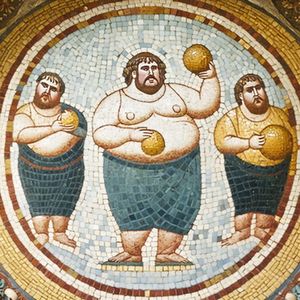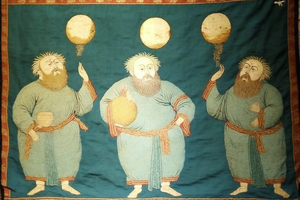The Orbsmen: Difference between revisions
mNo edit summary |
m (hyperlink) |
||
| Line 1: | Line 1: | ||
[[File:Orbsmen Mosaic.png|thumb|A mosaic possibly depicting Orbsmen circa 3rd Century unearthed in [[wikipedia:Sardis|Sardis]]]] | [[File:Orbsmen Mosaic.png|thumb|A mosaic possibly depicting Orbsmen circa 3rd Century unearthed in [[wikipedia:Sardis|Sardis]]]] | ||
'''The Orbsmen''' (/‘[[wikipedia:Help:IPA/English|ɒɹbsmɪn]]/; from the Middle English: Orbe Men, “Orb Men”) were a [[wikipedia:Secret_society|secret society]] and [[wikipedia:Gnosticism|Gnostic]] movement who practiced [[The Orbsmen|Orbism]] between the 11th and 15th centuries and throve in [[wikipedia:South_East_England|South East England]]. Followers were described as Orbers, Orbsmen, or simply Orbs, and are now mainly remembered for producing remarkably perfect orbs, their socially alienating behavior and appearance, having apparently recorded or collected etchings depicting [[wikipedia:Ford_Pinto|modern vehicles]] and the theory of [[wikipedia:Special_relativity|special relativity]], and being executed en masse following an individual Orbsman’s assault of [[wikipedia:Elizabeth_of_York|Elizabeth of York]] in 1486. | '''The Orbsmen''' (/‘[[wikipedia:Help:IPA/English|ɒɹbsmɪn]]/; from the Middle English: Orbe Men, “Orb Men”) were a [[wikipedia:Secret_society|secret society]] and [[wikipedia:Gnosticism|Gnostic]] movement who practiced [[The Orbsmen|Orbism]] between the 11th and 15th centuries and throve in [[wikipedia:South_East_England|South East England]]. Followers were described as Orbers, Orbsmen, or simply Orbs, and are now mainly remembered for producing remarkably perfect [[orbs]], their socially alienating behavior and appearance, having apparently recorded or collected etchings depicting [[wikipedia:Ford_Pinto|modern vehicles]] and the theory of [[wikipedia:Special_relativity|special relativity]], and being executed en masse following an individual Orbsman’s assault of [[wikipedia:Elizabeth_of_York|Elizabeth of York]] in 1486. | ||
== Early medieval period == | == Early medieval period == | ||
Revision as of 14:25, 9 March 2023

The Orbsmen (/‘ɒɹbsmɪn/; from the Middle English: Orbe Men, “Orb Men”) were a secret society and Gnostic movement who practiced Orbism between the 11th and 15th centuries and throve in South East England. Followers were described as Orbers, Orbsmen, or simply Orbs, and are now mainly remembered for producing remarkably perfect orbs, their socially alienating behavior and appearance, having apparently recorded or collected etchings depicting modern vehicles and the theory of special relativity, and being executed en masse following an individual Orbsman’s assault of Elizabeth of York in 1486.
Early medieval period
The earliest confirmed reference to Orbsmen is contained in the writings of Rundicci the Third of Lombardy (556 – 600 CE). In volume 54 of his seminal work, Historia Hominum Alienorum, Rundicci described a group of celibate, orb-loving men who transported orbs from the Eastern Roman Empire to western Europe through treacherous mountain passes in the Swiss Alps. He noted that these men (known as "Orbi") took no wives, but "loved the round orbs in the manner that a man would love his wife."
Late medieval period
After centuries of silence, references to a secret organization known as "Orbers" begin to surface in the archaeological record of mid 15th century England. Perhaps the most significant of these findings is The Orber's Codex, which sets forth Orber customs, including their unusual dress codes and initiation rituals. Although the Codex's authorship is disputed, most historians credit reclusive English nobleman Lord Orber (1419 –1486 CE), the de facto leader of the Orber movement during the period.
Although little is known of Lord Orber, he is referenced in letters of Lord Horingsworth 3rd Duke of Cornberry (1449 –1523 CE). In one letter, Lord Horingsworth warned of a man living in an underground sphere near the path between Cornberry and Bournestead:
"Please do not tread on his land, for if you do, this man is much dismayed and arises from his hole, throwing hard orbs and screaming loudly."
